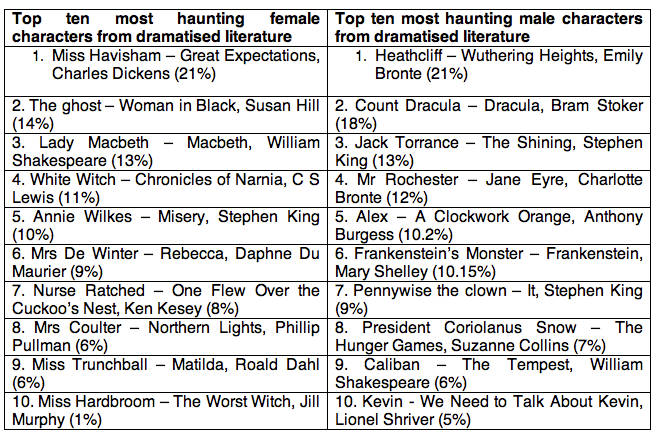April Flanagan from the British television Drama Channel sends along this amusing bit garnered from audience surveys that shows how many characters that originated in Victorian novels remain in the minds of viewers — George P. Landow.
LONDON, Monday 19 May 2014: He is a tortured romantic hero whose passions destroy both himself and those around him, while she is a decaying spinster described as ‘the witch of the place’, as Heathcliff and Miss Havisham top the lists of the most haunting characters in British literature according to new research released today.


Drama TV shared these images of their conception of Miss Havisham, that on the left Gillian Anderson, on the right a photo that the press release entitles What the Dickens? Miss Havishams invade London! Shocked commuters come face-to-face with Charles Dickens’ haunting character. Now who do you think looks most like your idea of Miss Havisham. Anderson looks like a young and beautiful woman going to a costune ball as Miss H and not all that convincingly aged. The middle Havisham on the escalator probably succeeds best. But why didn't they choose much older women as models?
The survey of 2,000 British adults was commissioned to mark the screening of Great Expectations on TV channel Drama, and asked respondents to select their most haunting characters from a long list of over 50 iconic personalities from the pages of well-loved fiction. Great Expectations will be shown on the channel on Sunday 25 May [2014] at 6pm and repeated on Monday 26 May at 4pm.
Eternal bride-to-be Miss Havisham, played by actresses including Gillian Anderson (2011), Helena Bonham Carter (2012) and Charlotte Rampling (1999), was voted the most haunting female character with a fifth of the vote (21%), suggesting that the character is one that stays with readers long after they have put the book down. The ghost from Susan Hill’s chilling tale of The Woman in Black comes second (14%) and the top three is completed by the forceful Lady Macbeth, created by William Shakespeare, more than 400 years ago (13%).

Emily Brontë’s brooding gypsy foundling Heathcliff from Wuthering Heights was voted the most haunting male character with 21% of the vote. He is followed by Bram Stoker’s terrifying Count Dracula (18%) and Jack Torrance from The Shining (13%).
Stephen King has the most entries in the list with Annie Wilkes from Misery (10%) and Pennywise the clown from it (10%), as well as Jack Torrance, all featuring. Shakespeare features twice with Lady Macbeth (13%) and Caliban from The play (6%).
The most haunting locations from British literature
The findings also reveal the most haunting locations from British literature, with the windswept North Yorkshire Moors from Emily Brontë’s Wuthering Heights taking the top spot (51%). This is followed by Whitby from Bram Stoker’s vampire classic Dracula (28%) and in third place were the eerie marshes from Dickens’ Great Expectations (27%).
Regional differences
The findings also reveal some interesting regional differences with respondents from East Anglia the most likely to vote Bram Stoker’s Count Dracula the most haunting character (22%), compared with a national average of (18%). In Yorkshire, respondents are most likely to be haunted by Heathcliff long after putting the book down, with 28% favouring it, compared to the national average of 21%. Miss Havisham outperformed the 21% national average in Northern Ireland (26%), East Anglia (25%) and the South West (25%).
Adrian Wills, General Manager, Drama says, “Great literature, like great drama, is all about characters. Our top ten lists the characters that stay with you long after you have put the book down, from the mysterious to the menacing. Miss Havisham is a disturbing character because her desire to take revenge results in sentencing Estella to a life of misery. The ethereal, haunting character was portrayed brilliantly by Gillian Anderson in this most recent adaptation and we are delighted to be sharing this with viewers on Drama this bank holiday weekend.”
Related Material
- Pip, child and adult in the 2014 Drama Channel's Great Expectation
- Estella, child and adult in the 2014 Drama Channel's Great Expectation
Last modified 23 May 2014